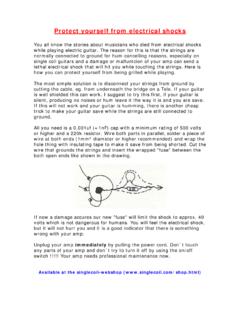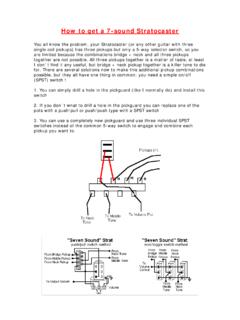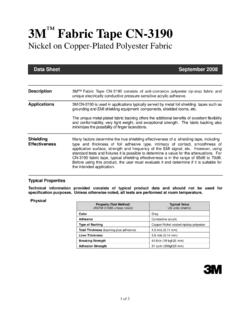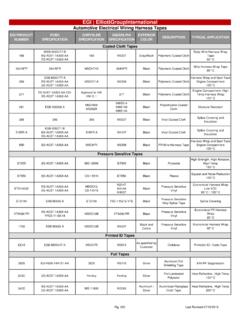Transcription of Quieting the Beast, Shielding a Strat™ - SINGLECOIL.COM
1 Quieting the Beast, Shielding a Strat This modification does not alter the appearance of your guitar. Last updated 1-3-2004 What some people have said after Shielding their guitars. Introduction Most guitars with single-coil pickups suffer to some degree from hum. Almost all are much noisier than they need to be, because the manufacturers don't bother to shield them well and don't follow simple electronic wiring principles that have been known for decades. This holds true even for many premium guitars costing thousands of dollars. Even some guitars equipped with humbuckers can benefit from good Shielding and grounding guitars that pick up local radio stations are good examples.
2 These instructions apply primarily to guitars with regular magnetic pickups. Doing the Shielding won't cause any problems with newer "noiseless" pickups like Lace sensors, but neither will you see much reduction in hum (which should be almost nonexistant anyway). You may, however, notice a significant reduction in buzz from flourescent lights and such. Often, this noise is picked up in the controls rather than the pickups. That is why you will sometimes hear this noise even with humbuckers or with a Strat in the 2 and 4 positions. Many guitars with single-coil pickups will benefit noticeably from Shielding and star-grounding as described here. Generally speaking, the more noisy your guitar is the more noticeable the improvement will be.
3 In fact, I am beginning to hear from more and more people who are opening up new guitars and finding Shielding paint, etc. Good wiring and Shielding are by no means yet the norm, but before you start ordering Shielding supplies have a quick look in your guitar and also compare it to other similar guitars if your guitar is already significantly quieter than most other similar models, you aren't going to see a lot of improvement after following these instructions. These step-by-step instructions and illustrations are for Stratocaster type guitars but the principles and techniques can be applied to any guitar. Shielding a Telecaster type guitar is even easier here are some photo-illustrated instructions using a 1996 Standard (MIM) Fender Tele.
4 Shielding and regrounding your guitar will not signficantly alter its tone, other than that it may sound a bit more alive because faint harmonics that were buried in hum can be heard more clearly when the hum is removed. Also, you will typically be able to play at higher gain levels before hum becomes objectionable. This means more tube saturation and sustaining feedback. These instructions have been online at various URLs since early in 1996. During that time I have never received an e-mail from anyone who wanted to know how to put the hum back into their shielded guitar! Probably the greatest benefit of reducing hum is the accompanying increase in sustain and dynamic range.
5 As you reduce hum you can crank the gain higher on your amplifier before the hum becomes intrusive. With the increased gain you get better sustain and you can vary your picking attack for much better dynamics as you play. I think many guitarists have become so accustomed to hum that they've fallen into the habit of adjusting amplifier volume to the point just below where hum becomes annoying. I've heard from a few people who reported that there wasn't much reduction in hum after Shielding . Occasionally we find that they missed something in the instructions. Less frequently we find that they had really hot overwound pickups and/or pickups mounted high in the pickguard ( for a guitar with high action) and in these cases directly Shielding the pickups solved the problem.
6 Still less frequently we find that they had shielded one of the rare guitars that was pretty well shielded at the factory so there wasn't much noise to begin with (in the last few years more and more guitars are recieving at least a shot of Shielding paint by the manufacturers but even this is still far too rare). But, almost all of those few who initially report little reduction in hum say things like, "my guitar sounds much better now and sustains better but it still hums about as much as before." Most have had the good grace to feel a bit sheepish when I point out that it sounds better and sustains better because they are playing at much higher gain levels and that they can play at those higher gain levels because of the reduction in hum!
7 Principles and Practices Good practices and principles improve the noise resistance of any circuitry. These practices are almost universally applied by ll l tif ttthkil t iit!Mfttil lli ittiiall electronics manufacturers except those making electric guitars! Manufacturers routinely sell expensive guitars containing wiring that a manufacturer of $25 cassette players would never tolerate. The practices and principles almost universally ignored by electric guitar makers are simple and have been known and practiced by manufacturers of other electronic items for decades: Shield components that are susceptible to noise especially long wire runs, coils of wire, and high impedance circuit paths.
8 Avoid ground loops. That doesn't sound too difficult, does it? It's not. These instructions will show you how to apply the simple principles above to reduce hum and vastly increase immunity from high-frequency interference as well. Though the before and after schematics look very similar, in reality quite a few ground wires have to be moved to correct the wiring practices that contribute to noise. These non-artist's renderings show the differences between the stock factory wiring and the properly shielded and grounded circuit much more clearly. Skills Needed You will have to do some soldering, if you've never soldered I recommend that you get a pamphlet on the subject and practice on scraps of wire and such before working on your axe.
9 You also need the ability to follow written instructions and the patience not to rush through the modification haphazardly. Beyond that, if you've learned to play guitar then you should have the manual dexterity to follow these instructions. I suggest that you print this page, read it through several times, and then check off each step as you complete it. (Note that these instructions assume a Stratocaster guitar -- modify as needed for other types.) Tools Needed All of the following are available at Radio Shack stores. Many hardware stores will also carry these tools and possibly at better prices. Soldering iron (an inexpensive 30-watt pencil is fine). Note that I've intentionally developed instructions that avoid having to solder any wires to the shells of potentiometers.
10 Many people have difficulty making good connections to pot shells without damaging the pot or other components. If you must ignore my advice and solder directly to a pot shell, you will need a larger iron or a soldering gun. Desoldering pump or bulb. Wire cutters and strippers. Sharp hobby knife or single-edge razor blades. Small crescent wrench or hollow-shaft nutdriver that fits the mounting nuts on your control pots. Screwdrivers that fit the pickup mounting screws and pickguard and jackplate mounting screws. Heat gun (optional). Very nice for shrinking heat-shrink tubing very cleanly for a professional appearance however, don't go out and buy one unless you plan on doing a lot of wiring.











